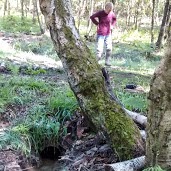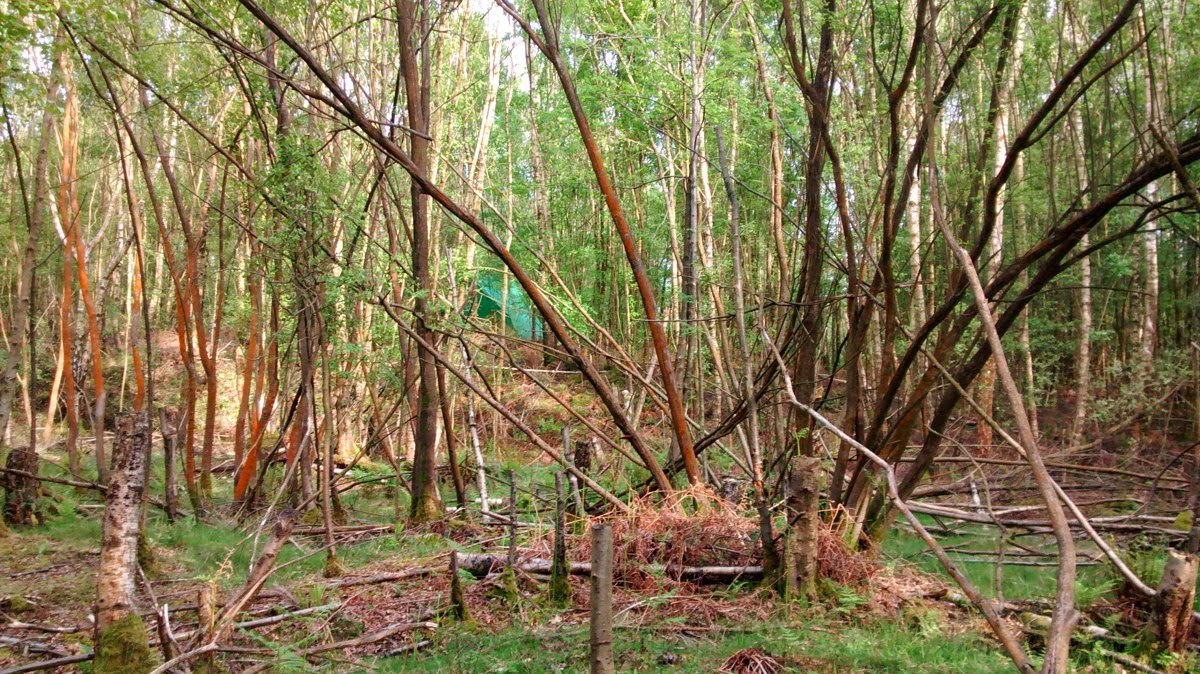Fallow deer originated in the Mediterranean and Middle East, and introduced to Europe by the Romans. The Normans then introduced them to Britain for hunting where they were originally kept in royal forests and deer parks. Over the centuries they escaped, hunting ceased and their natural predators, wolves and bears, exterminated. Their numbers grow, largely unchecked.
Some localised culling of UK deer is carried out occasionally but increasing numbers are having an adverse impact on natural habitats , wildlife and the foodchains they support.In 2009/10 the largest herd of deer counted in Old Copse numbered twenty. In January 2011 (this year) on one day thirty were counted and it's thought there were more as they were difficult to count in dense birch.
They feed on virtually anything green and will strip the bark from young saplings and shrubs, both grazing and browsing up to a height of 1.8 metres, causing damage above that height by biting through thin stems to make them fall within their reach. The males cause damage by stropping the felt from their antlers on thin saplings, often fatally damaging the bark in the process. Fortunately, bluebells are poisonous to them and they don't like foxgloves.
Most surviving understorey plants are above browsing height. Honeysuckle and ivy only exist where they have reached above browsing height in the past and there is minimal bramble despite there being plenty of seedlings.There are saplings a decade or so old but few escape an are new and less than browsing height. There is a continually regenerating seed bank as, in the spring and summer, new seedlings can be seen, but these are soon grazed. They are quite often seen on the increasingly grassy and (in the damper parts) rush covered Ride. but don't appear to eat much of this, preferring young oak leaves etc Their increasing numbers have an adverse impact on natural habitat, and the foodchains they support, not only at Old Copse but all over the UK.
Beautiful as these creatures are, there are far too many for our 30 acres to support as can easily be seen by the poor regeneration in the wood. They are remarkably unconcerned by our presence. Seen browsing on the ride, they have a good stare until we get quite close, when they amble off into the wood. In contrast, as soon as they see Stuart the deerstalker, with his camouflage clothing and rifle, they make themselves scarce. In 2009/10 the largest herd of deer counted in Old Copse numbered twenty. In January 2011 on one day thirty were counted and it's thought there were more as they were difficult to count in dense birch.These numbers will keep increasing without regular (successful) stalking They are remarkably unconcerned by our presence.
Stuart just emailed the records of his two seasons deer stalking at Old Copse. The fallow season runs from October 1st to March 31st. During the first season - 2012/13 he managed , with the occasional help of a colleague, to pot 11 out of a target of 12. Only 6 were bagged in the 2013/14 season, possibly because of disturbance caused by timber felling and subsequent cabin building from mid-February this year. I should think that this rate of attrition barely covers the rate of fallow deer reproduction, so we will have to step up our efforts if we are to have much hope of successful regeneration at Old Copse. We are looking for someone certificated and possibly retired who lives nearer to the wood than Stuart, and willing to sit in a deer seat for the necessary hours it can take to get lucky. Perhaps this, plus temporary deer fencing might make a difference.
We had never tasted venison before, and though we tried hard - roast haunch, braised shoulder, pan-fried peppered fillet with a wine and blackberry sauce - we've come to the conclusion that we don't actually like the stuff. It's something to do with the texture, both grainy and mushy. This is a shame as wild venison is supposed to be healthy , and the deer have been despatched swiftly and humanely. Still, friends and family seem to like it , so I expect we'll manage to find a home for some more of it next winter.

















